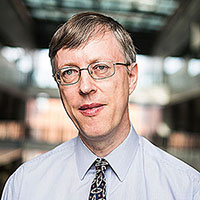By Nicholas Higham
| How to Have Great Ideas |
I had been thinking about creativity
for some time, and was stuck. Can
you have ideas “on demand”? That
seems crazy; ideas just “happen,”
don’t they?
These thoughts were on my mind
as I browsed the window of a game
shop, seeking a present for my
son’s eighth birthday. Then I saw a
chess set, with all of the pieces laid
out. But something was wrong —
whoever had placed the pieces did
not know the rules of chess, as the
positions of the knights and bishops
had been flipped. BANG!
Creativity! That’s it!
As we all know, the starting
positions of chess pieces are
predetermined: the rooks in the
corners, the king and queen in the
middle, the pawns at the front. But
suppose players could choose
where to put their pieces. Game
play would then be different, and
none of the conventional gambits
would work.
I became aware of “chess variants”
much later, but that sudden insight
answered my question about
creativity — how to have ideas “on
demand.” Start with what you
know (in chess, all the starting
positions are given), ask how this
might be different (“suppose the
rooks do not start in the corners”),
and then let it be...
It’s that simple, and it works every
time. This philosophy also embodies
two very important first principles:
• When it comes to creativity, the
goal is not novelty, but rather
difference — difference from the
status quo, which is nicely grounded
in reality, for we know what the
status quo is.
• As Arthur Koestler points out in
The Act of Creation, creativity is the
discovery of a fresh pattern formed
from existing elements, not a “bolt
from the blue.” It is all about things
that are already there, simply
configured in different patterns and
combinations.
— Dennis Sherwood
Dennis Sherwood runs his own U.K.-
based consultancy, The Silver Bullet
Machine Manufacturing Company Ltd.
|
At the end of April, SIAM held a two-day strategic planning workshop called ADVANCE. The 25 attendees included SIAM officers and staff, as well as other members of the SIAM community selected to bring a diverse range of viewpoints. The event, which took place just outside of Philadelphia, Pa., was facilitated by consultant and creativity expert Dennis Sherwood (seeaccompanying sidebar).
The impetus for the workshop came from the July 2017 Board and Council meetings, at which attendees recognized that it was timely for SIAM to engage in some strategic planning. The Board duly authorized the expenditure necessary to run an appropriate event. Over several months, executive director Jim Crowley, chief operating officer Susan Palantino, and I developed—in consultation with Sherwood—a set of approximately 30 exercises for workshop use. Each one presented a list of questions on a particular topic and asked breakaway groups of six or so participants to individually and silently write down their thoughts, share them with each other, and then ask, “how might this be different?” The topics included journals, membership, diversity, conferences, fundraising, chapters and sections, new products, and the ways in which SIAM could make use of unlimited funds (a dream scenario designed to encourage new ideas).
Members of the SIAM community gather in a breakaway group to discuss membership opportunities during ADVANCE, a recent strategic planning workshop that yielded various ideas about future directions for SIAM. Photo credit: Dennis Sherwood.
The group generated a large number of objectives that SIAM staff, officers, committees, and the Board and Council will take forward, including through discussions at the 2018 Annual Meeting in Portland, Ore., this July. One idea aims to substantially increase SIAM’s fundraising efforts. Others target various aspects of SIAM’s journals programme, especially the utilization of technology; the provision of a vehicle for industrial members to communicate open problems and interesting applications; the enhancement of membership benefits; and an increase in the number of SIAM sections and student chapters.
A recurring theme was the need to better exploit data when making decisions, though participants recognized that the required data is not always easy to obtain. Sherwood pointed out that inadequate data is often an excuse for organizations’ lack of action, and urged that SIAM not fall into this trap.
After two long days of hard work, ADVANCE participants were exhausted but energized by the productive discussions. Several contributors observed that achieving the workshop’s results would have been difficult with the (necessarily) short discussions that occur at Board and Council meetings, and that the group of attendees was even more diverse than at those bodies.
I look forward to working with SIAM staff and volunteers to take the ideas forward over the coming months.
Cartoon created by mathematician John de Pillis.
 |
Nicholas Higham is Royal Society Research Professor and Richardson Professor of Applied Mathematics at the University of Manchester. He is the current president of SIAM. |